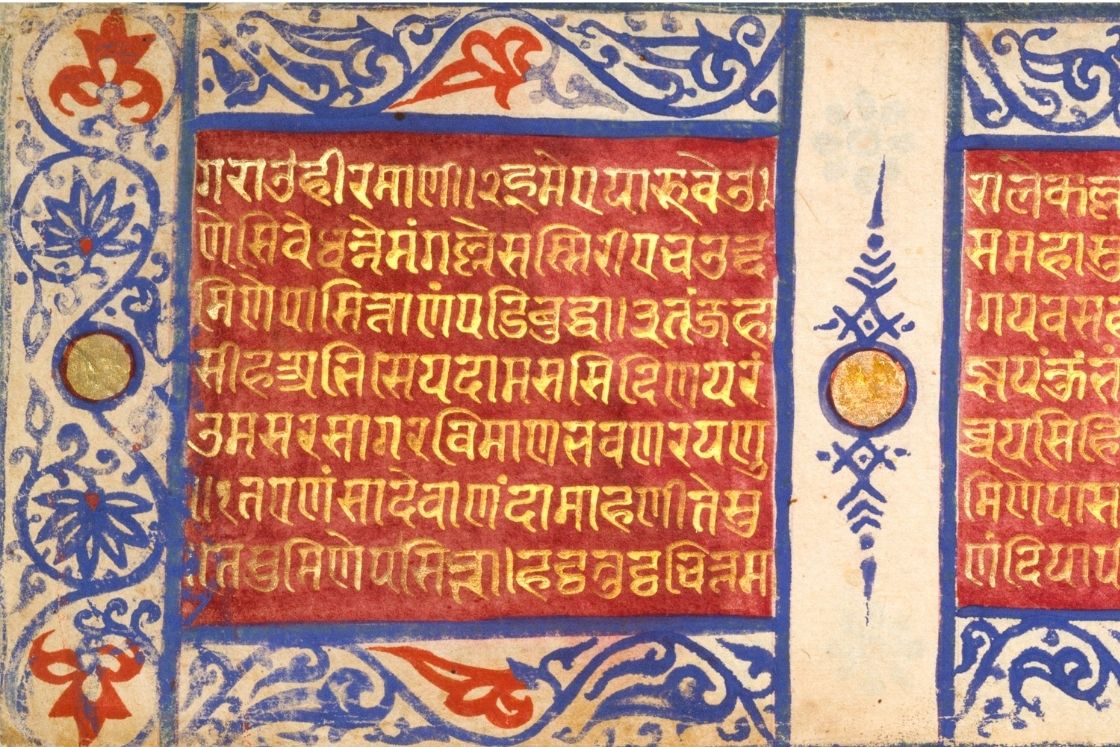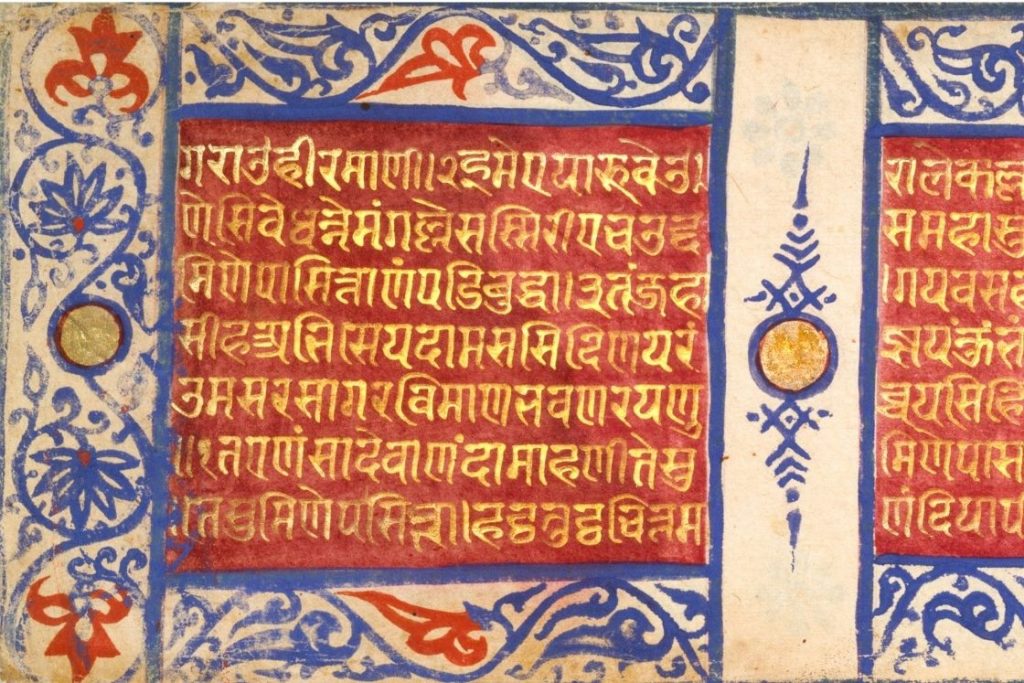11 Common Sanskrit Words in Yoga and Their Meaning
Sanskrit is the most ancient language in the world, often referred to as the “Mother of all languages.” It holds a prestigious position among the 22 official languages of India and is comparable to the ancient Latin and Greek...


Sanskrit is the most ancient language in the world, often referred to as the “Mother of all languages.” It holds a prestigious position among the 22 official languages of India and is comparable to the ancient Latin and Greek languages.
Most Hindu scriptures are written in Sanskrit, making it essential to understand the language. Sanskrit, which is over 3500 years old, was once considered a status symbol and a mark of elegance in ancient times.
The significance of Sanskrit in yoga is evident, as most yoga asanas are named in Sanskrit. Additionally, many modern Indian languages are either directly derived from or influenced by Sanskrit. To master subjects like Ayurveda, Yoga, Astrology, or to read any of the four Vedas and other Hindu scriptures, a clear understanding of Sanskrit is necessary.
Beyond Hinduism, Sanskrit is also the philosophical language of Buddhism, Jainism, and Sikhism, with some texts in these religions written in Sanskrit. Finally, the universal sound “OM,” used by yogis, meditators, spiritual gurus, and seers to relax the mind and connect to higher realms, is itself a Sanskrit word.
Origin of Sanskrit
The oldest form of Sanskrit, Vedic Sanskrit, is the language in which the 4 Vedas of the Hindu religion have been written and compiled. The compilation is said to have taken place somewhere between 1700-1200 BCE and the language is believed to belong to the Indo-Aryan family.
The basic Vedas are Rig Veda, Sam Veda, Yajur Vedia, and Atharva Veda which contain hymns, incantations, philosophies, and guidance for Vedic priests. It is believed that these Vedas are a direct revelation to the seers of the Aryan people.
Around 1000 BCE, the Vedic Sanskrit began its transformational phase from the first language to the second language that was meant for religion and learning. During 500 BCE, ancient scholar “Panini” worked on grammar which gave birth to Classic Sanskrit. This is the language in which some of the most famous dramas, poems, and epics have been written. The classical Sanskrit is the Sanskrit we see and know today.
Sanskrit Alphabets, Grammar, and Vocabulary
Sanskrit has 46 alphabets in its vocabulary which is written in Devanagari script. It is the same script in which most Indian languages are and is written from left to right. The vowels are nasalized and the vowel length makes the difference in the word meaning. However, the number of consonants is debatable yet it is said that the inventory is quite large.
The Sanskrit language uses prefixes, suffixes, infixes, and reduplication to form the words. Sanskrit grammar consists of 3 nouns – single, dual, and plural whereas the verbs are broadly classified into 2 groups – thematic and athematic. So when a Sanskrit sentence is formed, the verb is usually placed at the end, however, there can be certain exceptions to this.
Relation of Sanskrit and Yoga
Just like Sanskrit, yoga is also an ancient practice, the mention of which is found in ancient Hindu scriptures. And since the scriptures have also been written in Sanskrit, the yoga asanas and techniques must be also in the same language. Moreover, the teachings and knowledge have been passed on from the teacher to the student in the same language, hence it is also a form of keeping a tradition alive.
Another factor is that certain Sanskrit sounds have healing effects. The most common word, OM, is chanted to gain the benefits of the vibrational frequency of the letters ‘a’, ‘u’, and ‘m’. It is also said that the vibration of this word represents the sound of the entire universe.
Lastly, using Sanskrit words in yoga provides clarity and maintains the meaning of a word, which may be lost in translation.
11 Common Sanskrit words used in Yoga
Though there is a multitude of words that can be used with yoga, the below 11 Sanskrit words are used commonly in yoga sessions.
1. Yoga – Often pronounced as ‘yo-gaa’, it is derived from the Sanskrit word ‘yuj’ which means to ‘unite’ or ‘to join’. Surprisingly, this word doesn’t have a direct English name, like some other Sanskrit words. When practicing yoga, you are seeking to unite your mind, body, and spirit and also a union between self and Divine.
2. Asana – It is pronounced as ‘aah-sa-nah’ and it means pose or seat. This word is the most common as it comes in the names of almost all the yoga pose names. Every student and yoga practitioner will come across this word in each yoga session. It is a most important part of hatha yoga and involves a lot of physical movement.
3. Namaste – Pronounced as ‘na-ma-sthey’, it is the common form of greeting in the Hindu religion. The Sanskrit translation of the word is ‘I bow to you’, however, in terms of yoga, it can also mean ‘the divine light within me bows to the divine light within you’. It is quite literally the Indian version of saying ‘hello’ or ‘hi’.
4. OM – Another common word, used as a chant is OM and is pronounced as ‘ohhmmm’. According to the Hindu tradition, this word is the original sound and the sound that is the creator of other sounds of the universe. You will often find this word on the walls of the yoga or meditation studios, in the homes of most Hindu families, and even in restaurants.
5. Prana – The life force present in each of us is pronounced as ‘praa-nah’. The Sanskrit meaning of prana is ‘breath’ and it flows in all living beings. This concept is present in almost all the cultures of the world such as Ki in Japanese, Holy Trinity in Christianity, Chi in Chinese, etc.
6. Bandha – It is pronounced as ‘bahn-da’ and it means a ‘tight lock’. The bandha is a way to constrain the flow of prana through constriction of the muscles and internal focus. It is often used during pranayama and chakra yogas to maintain the flow of energy. Some common bandhas are Mula Bandha for Root Chakra, Uddiyana Bandha for Solar Plexus Chakra, and Jalandhara Bandha for the Throat Chakra.
7. Dhyana – The word is pronounced as ‘theeaa-nah’. The literal translation is ‘focus’ and it is a form of relaxing meditation that is often used as a warm-up before a yoga session. The Dhyana is also the 7th limb of Patanjali’s eight limbs of yoga.
8. Chakra – The pronunciation of this word is ‘chuck-rah’. In Sanskrit, chakra translates to ‘wheel’ and in the perspective of yoga, they are spinning wheels of energy that are present along the spine. Each chakra spins clockwise and has a specific emotion, color, and element attached to it. Various yoga asanas are directed to keep the chakras in balance or activate them.
9. Mudra – It is a symbolic hand gesture and is pronounced as ‘mooh-druh’. These hand gestures are an essential part of yoga as they help in regulating the prana and well regulating your doshas.
10. Mantra – It is pronounced as ‘mun-truh’ which means words or group of Sanskrit words that have spiritual significance and resonance. These Sanskrit sounds have a profound effect on the mind during meditation or yoga. OM is the most common of all the mantra that is chanted before, during, or after the yoga or meditation sessions.
11. Guru – the word is pronounced as ‘goo-roo’ which means a teacher. If we break up the word, ‘Gu’ means remover and ‘Ru’ means ignorance or darkness. Hence a guru is a learned person who helps you remove your ignorance by imparting divine knowledge. This is why yoga teachers are called gurus as they are helping you attain your physical and mental well-being.
Sanskrit Glossary of Yoga
1. Sanskrit Words Starting with A
Abhyasa (ah-bee-yah-sah) – repetition or constant practice. Willful and focuses spiritual practice.
Adho (ah-doh) – downward. The term is used in a yoga asana Adho Mukha Svanasana or Downward-facing Dog pose
Ahimsa (ah-himn-saa) – nonviolence or non-harming. The termed was embodied by Mahatma Gandhi
Ananda (ah-nun-dah) – the highest state of being or bliss.
Ashram (ah-shrum) – a yoga school or hermitage
Ashtanga (ush-tun-ga) – eight-limbed yoga. The eight-limbed path as described by Patanjali in Yoga Sutra. Also, Ashtanga Vinyasa Yoga is an athletic part of hatha yoga.
Ayurveda (ayoor-ved-ah) – the science of life. In today’s context, it is a holistic form of medicine involving plants that have minimal side effects.
2. Sanskrit Words Starting with B
Balak (baa-luck) – boy or a male pupil
Bhagavad Gita (bhug-vud-gee-taa) – an ancient book which details about yoga, that is a part of the famous Hindu epic Mahabharata.
Bhagavan (bhug-va-nuh) – the Lord, Creator
Bhakti (bhak-tee) – cultivating love and devotion to the divine without question.
Bija (bee-juh) – seed. Source. The bija mantras are core sounds with spiritual power. OM is one such commonly used bija mantra.
Brahma Nadi (bruh-muh-nuh-dee) – an energetic channel along the spine that is related to connecting the human experiences with universal consciousness.
Buddhi (bood-hee) – the seat of wisdom. The highest form of mind.
3. Sanskrit Words Starting with C
Chandra (chun-drah) – the moon
Chaitanya (chey-tun-yuh) – absolute consciousness
Chaturanga (chat-u-run-ga) – the yogic plank pose
Chinta (chin-tah) – worry
Chiranjivi (chi-run-jee-vi) – a person who has gained immortality
Chit (chih-tuh) – the conscious state of mind. Emotional and feeling component of the mind
4. Sanskrit Words Starting with D
Dana (daan) – charity, the aspect of selfless giving
Dasa (daas) – servant or slave
Devanagari (they-vuh-naa-giri) – the left to right script of sanskrit and other Indian languages.
Dharma (dhur-mah) – the purpose and path of life that will lead to peace, truth and enlightenment
Drishti (drish-tee) – a focal point to set your gaze and enhance concentration and focus during yoga practice. It is also the divine vision.
Dukha (du-khuh) – the feeling of sadness, grief
5. Sanskrit Words Starting with E
Eka (eh-kuh) – to denote number 1 in Sanskrit. Also used in many yoga poses such as Eka Pada Rajakapotasana, or One Leg Pigeon Pose.
Ekanta (eh-kaan-tuh) – seclusion or solitude
Ekata (ehk-tuh) – oneness or homogeneity
6. Sanskrit Words Starting with G
Gagana (guh-gun) – the sky
Ganapati (gun-uh-puh-ti) – a Hindu God that bestows success
Graha (gruhuh) – planets
Granthi (grun-thee) – tie or knot. One of the 3 blockages in the central energy flow which hampers the path of enlightenment in tantra yoga.
Guni (goo-nee) – a person with qualities
7. Sanskrit Words Starting with H
Halasana (hul-ah-suh-nuh) – a yoga asana that imitates a plough (hala)
Hanuman (huh-noo-maan) – a powerful monkey god who is a Lord Rama devotee. He helped Lord Rama fight the Ravana.
Hasta (hus-tuh) – hand or arm. Hasta mudras are hand gestures that are used during yoga and meditation
Hatha (huh-tuh) – forceful path. yoga performed to balance the sun and moon energy
Hridaya (hree-duyah) – the heart
8. Sanskrit Words Starting with I
Iccha (ich-chah) – desire or wish
Idanadi (ee-dah-nuh-dee) – the energy channel to the left of Brahma Nadi that connects the root chakra to the left nostril
Indra (in-druh) – a Hindu god of rain and ruler of heaven. The word can also mean mind or soul.
Itihasa (ee-tee-ha-suh) – history, epic such as Mahabharat or Ramayana
Iyengar (eye-yen-gur) – a popular yoga style that uses props like ropes, blankets, blocks and belts. It emphasized detail, precision and alignment of asanas
9. Sanskrit Words Starting with J
Japa (jup-uh) – repetitive chanting of mantras or prayers. A way to train the mind to concentrate and not have stray thoughts. It is often done with beads.
Janma (jun-muh) – birth, coming into being
Jati (jaa-tee) – class, species
Jiva (jee-vuh) – individual soul
Jnana (juh-naa-nuh) – a yogic path to spiritual wisdom and knowledge
Jyoti (ji-yo-tee) – light, illumination, luminosity
10. Sanskrit Words Starting with K
Karma (kur-mah) – the law of cause and effect. We are solely responsible for our actions and the effects we face.
Kirtan (keer-tun) – a devotional singing, chanting of hymns and mantras in a gathering
Kosha (ko-shuh) – a covering of the soul or sheath
Kriya (kree-yah) – physical action. Particular set of exercises in hatha yoga.
Kumbhaka (koom-bha-kah) – the holding of breath during pranayam
Kundalini (kun-duh-lee-nee) – the coiled energy at the root chakra that rises on awakening
11. Sanskrit Words Starting with L
Lajja (luj-jah) – shame or shyness
Lakshya (luck-shyuh) – goal, target, concentration point
Lila (lee-laa) – the divine play
Linga (lin-guh) – gender, symbol, sign
Lobha (low-bhuh) – greed
12. Sanskrit Words Starting with M
Mahan (maa-haan) – the great
Maharaj (maa-haa-raa-juh) – king
Mala (maa-laa) – rosary. Beads used for japa.
Manas (maa-nus) – the rational mind that processes senses and basic information.
Mandala (mun-daa-laa) – a geometric circular design that represents the cosmos. Commonly used in meditation
Maya (maa-yaa) – an illusion, the delusion of the mind to the worldly powers
Moksha (mok-shuh) – final enlightenment, the ultimate freeing of soul
13. Sanskrit Words Starting with N
Nabhi (naa-bhee) – navel
Nadi (nah-dee) – the channel of energy force in the body, psychic current
Nidra (nid-raa) – sleep, in a deep sleep state
Nirodhah (nee-rodh) – discipline, restriction, taming
Nirvana (neer-vaa-nuh) – liberation
Niyama (nee-yum) – the second limb of Patanjali’s eight-limbed yoga. It is a set of practices or rules that takes us on the path of self-purification.
Nritya (nree-tyuh) – dance, the dance of Lord Shiva is called Tandav Nritya.
14. Sanskrit Words Starting with O
Ojas (oh-jus) – spiritual energy or vigour
Omkara (om-kaa-ruh) – just like Om, it symbolises the sound at the creation of universe
15. Sanskrit Words Starting with P
Pada (puh-duh) – foot or leg
Patanjali (puh-tun-juh-lee) – an ancient Indian seer, philosopher and sage who compiled the Yoga Sutra.
Prakriti (pruh-kri-tee) – nature, primal nature of a being
Prajna (pruhg-nuh) – the highest awareness and consciousness
Pranayam (prah-nah-yah-muh) – the conscious controlled direction of breathing. It is also a common yoga practice.
Pratyahara (pruh-tyuh-huh-ruh) – withdrawal from the physical senses during meditation
Purna (poo-rnuh) – absolute, complete, full
16. Sanskrit Words Starting with R
Rachnatmak (ruch-naa-tuh-muck) – great creativity, ability to imagine, innovative and create original ideas
Rakta (ruk-tuh) – blood
Ratna (rut-nuh) – jewel, gem
Rishi (ree-shee) – seer, the one who seeks the truth
Rudraksh (roo-drak-shuh) – literally translates to Eye of Shiva. They are seeds of berries that are said to be holy and are worn as beads in arms, neck and used as japa mala.
17. Sanskrit Words Starting with S
Samadhi (sum-ah-dee) – the highest goal of the unitive state with the divine through meditation.
Sanskar (suns-kaar) – the developed habits or subconscious impressions that have been learned from ancestors and personal experience
Satya (sut-yuh) – the truth, reality
Savasana (shuv-ah-suh-nah) – the corpse pose. The final relaxation pose in a yoga or meditation class where you lie flat on the ground
Shakti (shuck-tee) – the feminine divine energy. power, force, energy
Shanti (shaan-tee) – peace, calm. A common mantra chanted in yoga or meditation sessions
Surya namaskar (soo-ryuh-nuh-mus-kaa-ruh) – the sun salutation. An intense yoga practice with multiple yoga asanas that are performed in a flow.
18. Sanskrit Words Starting with T
Tapa (tuh-puh) – heat building, intensity created by intense self-discipline and austerity.
Tantra (tun-tuh-raa) – a yoga type that focuses on the energetic side of yoga with stress upon japa of mantra and chakras
Tattva (tuht-vuh) – element, principle, essence
Tivra (tee-vruh) – intense, sharp, keen
Trataka (traa-tuh-kah) – steady gaze. An open eye form of meditation where you gaze at a point or candle flame without blinking to improve spiritual vision.
Tulsi (tul-see) – the Indian Holy Basil.
Tyaga (tee-yah-guh) – sacrifice, renunciation
19. Sanskrit Words Starting with U
Ujjayi (ooj-juh-ee) – victorious breathing. One of the common pranayama techniques
Upanishad (oop-nee-shud) – the portion of Vedas that imparts spiritual knowledge, ultimate realization and truth.
Upasana (oo-paa-suh-nah) – literally means to sit near. Also means devotion to God
Utthita (oo-tee-thah) – extended. Refers to asanas where you extend or stretch your body beyond the regular variation
20. Sanskrit Words Starting with V
Vairagya (vai-raa-gyuh) – the yogic practice of detachment and renunciation of worldly matters
Vata (vuh-tuh) – one of the three doshas or constitutions of the body that is related to the element of air.
Vayu (vaa-yoo) – wind, air, vital breath
Vedas (vey-dahs) – the oldest hindu scriptures that have details regarding yoga, chakras, doshas, etc. they are 4 main vedas, Rig Veda, Sama Veda, Yajur Veda, and Atharva Veda.
Vidya (vee-dyah) – knowledge
Vinyasa (vin-yaa-suh) – the sequence of two or more asanas that are performed in a fluid motion and synchronized breathing techniques. The most common vinyasa is the Sun Salutation.
Viveka (vee-vey-kah) – clear sight
21. Sanskrit Words Starting with Y
Yamas (yah-mah) – the guidelines or set of practices that let us practice moral restraint towards liberation.
Yantra (yun-truh) – a geometric design to invoke spiritual awakening
Yatra (yaa-trah) – journey, pilgrimage
Yoni (yo-nee) – womb, source, female organ of generation. The yoni mudra helps us achieve a calmness of mind and detachment from the chaos of the outer world. Yuga (yoo-guh) – the division of time in the Hindu religion. As per the Hindu religion there are 4 yugas- Krita, Treta, Dvapara and Kali. Starting from the 1st yuga, each yuga’s length is decreased by 1/4th. The duration of all the yugas are 12000 divine years and each yuga is divided into 360 human years. The proportion of each yuga can be divided into 4:3:2:1.
Final Thought
Sanskrit is a language that is difficult to learn due to the special phonetics, however, learning any different language needs patience. If you are successful, you will understand the meaning of each word that you are using regularly and also be able to experience a sense of clarity.
It will seem as if you are on a spiritual journey and will support your understanding of the culture. And who knows, that once you get a hang of the language, you may be able to understand the underlying meaning of each yoga asana on a higher level!

 ValVades
ValVades 
































